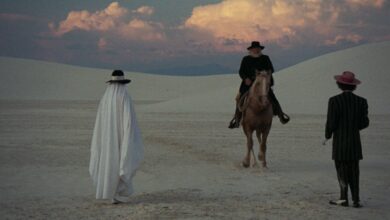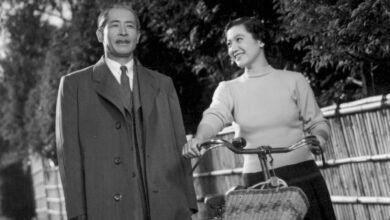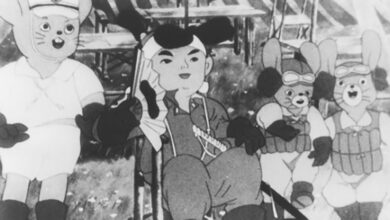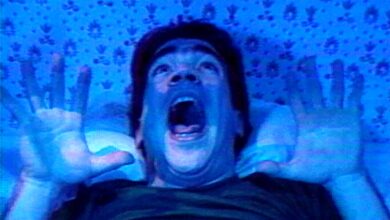
This article appeared in the July 18, 2025 edition of The Film Comment Letter, our free weekly newsletter featuring original film criticism and writing. Sign up for the Letter here.
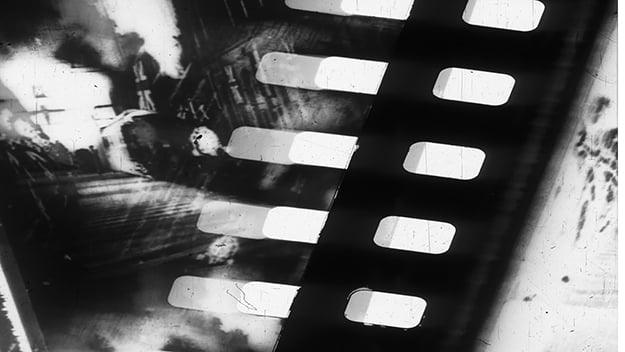
L’Arrivée (Peter Tscherkassky, 1997/1998)
Peter Tscherkassky will be receiving the Underground Spirit Award for “outstanding work in independent filmmaking” at the Paliç European Film Festival this month, and it’s easy to see why. Ever since he started experimenting with found footage in the 1980s, the Austrian auteur has made one masterful film after another, from mischievous minimalist works like Shot-Countershot (1987) to densely textured cubist films like Outer Space (1999) and Dream Work (2001). His most recent films are just as innovative and exciting as his earlier work. The Exquisite Corpus (2015) features a torrent of erotically charged images accompanied by musique concrète composed by Dirk Schaefer: a mesmerizing mélange of thunder, waves, crickets, and bird cries. And Tscherkassky’s most recent film, Train Again (2021), synthesizes shots of trains from feature films and advertisements with a phantasmagoria of images from film history, such as a hypnotic rotorelief from Marcel Duchamp’s Anemic Cinema (1926) and Danny riding his tricycle through the Overlook Hotel in Stanley Kubrick’s The Shining (1980).
I first became interested in having a conversation with Tscherkassky after reading “The Story Behind Outer Space,” a fascinating essay that he contributed to a new volume called Found Footage & Collage Films: The Artist’s Voice (edited by César Ustarroz, Found Footage Magazine, 2025). In it, he recounts the numerous accidents and contingencies that led to the creation of his most celebrated film, including how he received a print of Sidney J. Furie’s The Entity (1982) from fellow filmmaker Martin Arnold and how he got the idea to use a laser pointer to contact print and collage images from that film. We connected via Zoom this past April to discuss his work with found footage and his fascination with Futurism.
What is your relationship to mainstream narrative cinema? Are your works a critique of mainstream cinema?
No. I used to be highly critical of mainstream cinema, but now I love regular cinema. I love TV series. The Sopranos, The Wire, Succession—you name it. I’ve seen it all. I love cinema in all its forms. And I respect my found footage. If I use commercial narrative cinema, there’s always a deep respect for what has been accomplished in those films. I just try to create something completely new out of the preexisting narrative footage.
How do you want spectators of your films to think about the original films that you’re reworking? For example, you’ve made two great films—Outer Space and Dream Work—that rework footage from a horror film called The Entity. In your view, does a spectator gain a fuller appreciation of your films by seeing The Entity? Or is knowledge of the source material irrelevant to the works you’re creating?
Seeing the source materials disturbs the perception of my films. It does not help in any way. That’s why I prefer to use relatively unknown footage. The Entity is quite obscure. There were double-feature screenings that showed both The Entity and Outer Space. It didn’t work.
I just read your essay “The Story Behind Outer Space.” I was fascinated to learn how you started to use a laser pointer to engrave selected parts of images from a preexisting film onto unexposed film stock.
Yes. I was on the street and I saw three boys. They were thirteen or fourteen. Two of the boys were about to aim a laser pointer at the other boy’s eyes. He was the smallest of the three. I intervened. I said, “Are you crazy? You can’t do that!” They stopped torturing the small boy. As I kept walking, I suddenly thought, “Maybe a laser pointer could work as a light source in a darkroom.” I had made films before in a darkroom using the enlarger as a light source, covering some parts of the imagery and exposing other parts. But I had never used a laser pointer. Luckily, I already had a highly sensitive orthochromatic film stock that worked with the laser pointer.
When you started to use the laser pointer, did that allow you to be more precise in choosing which part of the source material you wanted to use in your film?
That’s an interesting question. Yes and no. Outer Space and Dream Work were mainly made with the laser pointer, and one single frame in those films is often composed of five to seven layers of found imagery. My films have a human touch. Since there’s so little red light in the darkroom, I do not see exactly which part I’m going to copy. So, I have to move the laser pointer around within the frame to search for what I intend to copy, and that is something that makes the film so human. I try to make films that could not be made with a computer. You could not tell a computer, “Find the face of Carla [the main character from The Entity, played by Barbara Hershey], but do not find it immediately. Look for it before you find it.” So, while the laser pointer is precise, there’s a certain kind of randomness as well.
Like Outer Space and Dream Work, your most recent film, Train Again, is densely layered. Often several images (or at least parts of images) are superimposed in a single frame. However, Outer Space and Dream Work only use footage from a single film: The Entity. Train Again, on the other hand, uses numerous sources. There are images from very early films like the Lumière brothers’ Workers Leaving the Lumière Factory (1895) and Edwin S. Porter’s The Great Train Robbery (1903). There are also images from a number of avant-garde films, such as Man Ray’s Return to Reason (1923) and Jean Mitry’s Pacific 231 (1949). There’s even footage from The Shining. What inspired you to create a film that features so many images from canonical films?
All of my films deal with cinema. My two most recent films, The Exquisite Corpus and Train Again, are especially interested in the specific artistic possibilities of analog film material and the machinery of cinema, so I tried to compare the machinery of the train with the machinery of the film projector and the analog camera. I present a train passing by, and I project onto that train pieces of classical avant-garde cinema. This creates a strong connection between trains and cinema and alludes to the fact that they’re both children of the industrial revolution. And film history is full of train films. It’s really amazing.
Before you made Train Again, you made L’Arrivée (1997/1998), which is also about trains.
Yes, Train Again refers to L’Arrivée. The latter is an homage to the Lumière brothers, who made the very first train film: The Arrival of a Train at La Ciotat Station (1896). The title Train Again also refers to a film by Kurt Kren called 37/78 Tree Again (1978), which itself refers to an earlier film that Kren made called 3/60 Trees in Autumn (1960). In fact, the time that elapsed between Trees in Autumn and Tree Again is the same as the amount of time that passed between when I made L’Arrivée and when I started working on Train Again: 18 years. So I dedicated Train Again to the memory of Kurt Kren.
What have you been working on since Train Again?
My next film will be inspired by Futurism, the Italian art movement from the beginning of the 20th century. Roughly speaking it lasted from 1909 to 1944, but the heyday happened between 1910 and 1920—before, during, and after World War I. And the Futurists were the very first artists who made avant-garde films. Unfortunately, many of the film negatives and prints were lost in the Second World War during a bombardment in Milan.
Do you know what kind of footage you’re going to be working with?
Yes. Oh God. I’ve got so much footage. Too much footage. But I’m mainly using Independence Day (Roland Emmerich, 1996) and Capricorn One (Peter Hyams, 1977) with Elliott Gould.
Are these films that you like? Or do you just find them useful for this project?
Useful. The Futurists were interested in visual dynamism, so that’s what I’m looking for. What the Futurists did with cinema was like a promise that was never fulfilled. I’m trying to achieve some of the goals that they had with cinema—and also with their paintings.
In almost all my work, I try to establish a connection to early film history, but in the case of the Futurists, I am not alluding to specific films. The early abstract film experiments of 1912 by Bruno Corra and Arnaldo Ginna have been entirely lost, and descriptions of Vita Futurista (Arnaldo Ginna, 1916)—sadly only three minutes survived—indicate a more Surrealist vein that I already addressed in Dream Work and The Exquisite Corpus. So, this time, I’m pursuing the spirit of Futurism as expressed in Marinetti’s first manifesto: “We declare that the splendor of the world has been enriched by a new beauty: the beauty of speed…A roaring motor car which seems to run on machine-gun fire is more beautiful than the Victory of Samothrace.”
This emphasis of pure dynamism ties in with Giacomo Balla’s motion-study paintings, attempts at capturing the dynamics of a passing car or the flight of a swallow (as in his painted versions of Étienne-Jules Marey’s chronophotographs). All of this helps me select motifs: the car, aerial imagery, the big city—but also war, which the Futurists hailed as “the only hygiene of the world.” These themes serve as a point of departure—no more, no less.
The fact is that many Futurists were highly skeptical of cinema or rejected it completely. Umberto Boccioni had serious doubts, for example, but I’m trying to make a film that might convince him!
This interview was made possible by the ExFM SIG (the Experimental Film and Media Scholarly Interest Group), an affiliate of SCMS (The Society for Cinema and Media Studies). The author would like to thank the co-chairs of the ExFM SIG—John Powers, Srijita Banerjee, and Oksana Chefranova—for their help in facilitating this conversation. The author would also like to thank Eve Heller for her perceptive suggestions and corrections.
Justin Remes is an associate professor of film studies at Iowa State University. He’s the author of Motion(less) Pictures: The Cinema of Stasis (Columbia University Press, 2015) and Absence in Cinema: The Art of Showing Nothing (Columbia University Press, 2020).
Source link

